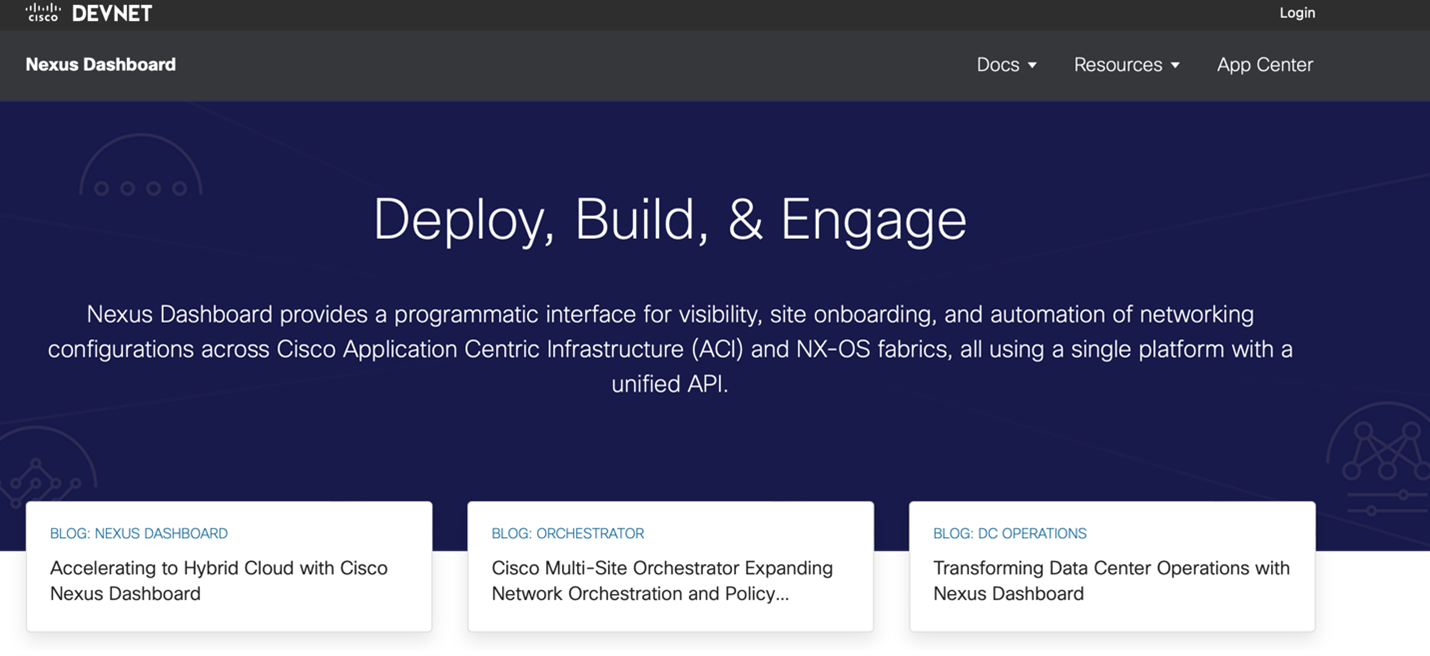New Sandbox for Nexus Dashboard and NDO

Management, operations, and observability for the modern datacenter
Our Cloud Networking (CN) BU has been putting in a lot of time to completely rethink management, operations, and observability for the modern datacenter, especially in our new hybrid work era. The result of this effort was Nexus Dashboard (ND), which serves as a foundational platform for the datacenter network and all the apps supporting it.
Thomas Scheibe has a great blog about what Nexus Dashboard really is. He talks about the challenge for IT to keep applications and networks in sync, and how an automation toolset is needed to securely manage the expansion to hybrid and multicloud.
New Nexus Dashboard Orchestrator (NDO) sandbox
For a while, there was a gap in the DevNet Sandbox catalog for anything related to Nexus Dashboard. So, while the features and benefits were being discussed and realized, our developers couldn’t touch anything that was using it. That wait is now over!
Within the Sandbox catalog, you can now find a reservable Nexus Dashboard Orchestrator (NDO) sandbox running on the latest version of ND, v2.2. The 2.2 release includes a lot of “foundational platform APIs.” This allows an infrastructure developer to manage configuration of the ND instance programmatically, such as changing authentication methods, or adding new sites to the deployment. This management can be done directly using the ND APIs. And, it will also be supported by Ansible and Terraform – allowing for the entire management lifecycle to be supported through Infrastructure as Code (IaC) tooling!
A single point of reference
Having the sandbox is great. It allows infrastructure developers to work with the technology first-hand. But, you say, “having the platform isn’t as valuable if there isn’t a complete complement of documentation and reference material available outside of the sandbox.”
Fortunately, we have you covered there too!
New Nexus Dashboard DevCenter
As part of our focus on API quality and developer experience, we released a DevCenter for Nexus Dashboard. There you’ll find a single point of reference for everything related to Nexus Dashboard programmability. In the DevCenter you’ll find:
- Getting started examples for the APIs of each of the supported services within Nexus Dashboard,
- API reference materials
- Supported integrations within ND
This page will always be up to date with the latest release API documentation, important developer related announcements to ND, and new integrations or support for tooling within the ND ecosystem – so it’s definitely worth a bookmark in your favorites if you plan on leveraging ND as a datacenter platform.
Nexus Dashboard Orchestrator vs MultiSite Orchestrator
In addition to Nexus Dashboard, the new sandbox also includes the latest version of Nexus Dashboard Orchestrator (NDO), installed and preconfigured with an ACI simulator added in as a site. While the name is different, users of the older MultiSite Orchestrator (MSO) will feel right at home navigating the UI within NDO. They’ll also benefit from a more unified login process and ease of access to the NDO app. (An improvement over previous versions running on the Application Services Engine of MSO in the sandbox).
Best of all, the Cloud Networking team has spent a lot of time and effort to ensure that all automation developed using Ansible or Terraform will be compatible with the shift from MSO to NDO with a few simple changes to the playbook or HCL file (I’ll have a blog about it as we must do the same thing for our lab sample code. Keep an eye out for it).
Test… then use!
All in all, this sandbox release allows our developers to test the latest platforms and APIs that they can then use to manage their modern datacenter fabrics. I’d love to hear about interesting use-cases, automations, or even just how automating ND has helped reduce your workload and toil in your day-to-day. You can always find me on Twitter @qsnyder – so feel free to tag me!
We’d love to hear what you think. Ask a question or leave a comment below.
And stay connected with Cisco DevNet on social!
LinkedIn | Twitter @CiscoDevNet | Facebook | YouTube Channel
Share:


